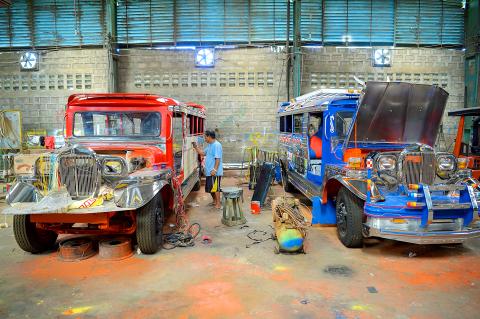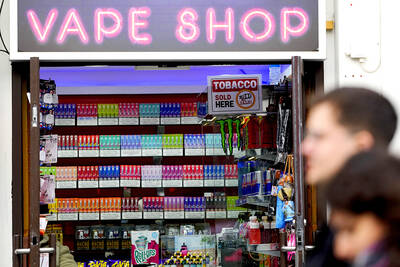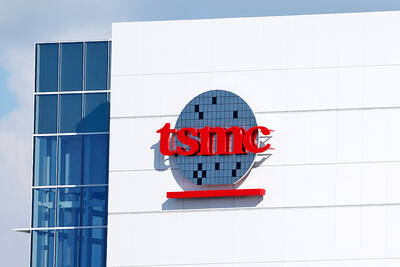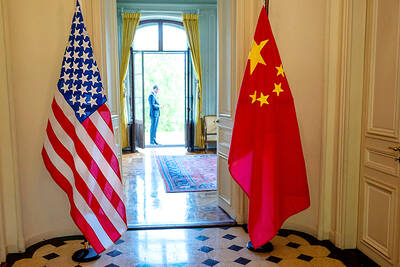Bernardo de la Cruz cast his eyes around the nearly silent workshop where he used to toil overtime hand-painting custom decor on jeepneys, the singularly Philippine minibuses facing the scrapheap. These rolling art galleries adorned with images of everything from Batman to babies, as well as disco lights and chrome wheels, have for decades provided cheap transport for millions.
However, pollution and safety concerns have led to a modernization program, with jeepneys 15 years or older to be taken off the streets by next year.
“This is an act of treachery against fellow Filipinos,” De la Cruz said. “This is a uniquely Filipino product. We were born with it.”

Photo: AFP
When he began 45 years ago, there were hundreds of artists giving the vehicles their famously boisterous paint jobs. Now there are estimated to be fewer than a dozen left.
He has seen orders decline from a high of up to 80 per month in the 1980s to just one or two now.
His canvas is being replaced by eco-jeepneys, powered by electricity or less-polluting diesel engines.
Riders of old jeepneys currently have to climb in through a hatch in the rear, cramming into the benches inside with no respite from the heat and roadside pollution.
The jeepney’s successor has been billed as a big improvement. It has doors, individual seats, air-conditioning and enough height to stand up. However, it is to be mass-produced and look just like a public bus.
Skipping over the jeepney’s bespoke production process in small workshops means a loss of the individual style and flair that made them global symbols of the Philippines.
“It’s one of the most genuine forms of modern folk art that we have,” said Bernie Sim, a Manila-based graphic designer and coauthor of a 2014 book on jeepney art.
French fashion designer Christian Louboutin launched a jeepney-themed handbag collection last year, while Swedish furniture giant IKEA painted a jeepney in its signature blue and yellow to announce plans to open a Philippine store.
However, the vehicles, which were first made from leftover US jeeps after World War II, have been on borrowed time for years.
Jeepneys are highly polluting and the Philippines is desperate to improve air quality in its traffic-clogged cities.
Their drivers are also notorious for ignoring traffic rules and the vehicles have few safety features.
In addition, Manila in 2014 ushered in Internet-based ride-sharing services and three years later Philippine President Rodrigo Duterte said that the jeepney must evolve or disappear.
“They have all but stopped making jeepneys,” 52-year-old jeepney artist Vic Capuno said.
As a result, he and a colleague at Armak Motors Corp now paint just three or four jeepneys each month.
De la Cruz worked on nine in the past year. He is the only painter left at Manila’s Sarao Motors Inc, once the country’s biggest producer.
Two of his siblings were also jeepney artists, but they died from diseases he believes were caused by years inhaling fumes from the paint. Yet, he is still passionate about the vehicle’s importance in Philippine history.
“When the jeepney disappears, a piece of Filipino culture will also die,” De la Cruz said.
A self-taught painter, he was inspired by the work of renowned local artists such as Carlos Francisco and Fernando Amorsolo.
His jeepney designs, still seen on the streets for now, chronicle the rapidly changing landscape of his home — Las Pinas — from a farming and salt-making backwater into a highly urbanized area.
“It’s a pleasing sight. It brings us back to a time and place that is no more,” De la Cruz said.
After raising four children on the pay earned painting, he now also creates canvases and makes storefront signs as a sideline.
He conceded that he could have a decent life without the jeepneys, but was heartbroken by the government’s decision.
“I would like to appeal to the authorities not to outlaw it,” De la Cruz said. “At times I cry quietly when I think about what is happening.”

Real estate agent and property developer JSL Construction & Development Co (愛山林) led the average compensation rankings among companies listed on the Taiwan Stock Exchange (TWSE) last year, while contract chipmaker Taiwan Semiconductor Manufacturing Co (TSMC, 台積電) finished 14th. JSL Construction paid its employees total average compensation of NT$4.78 million (US$159,701), down 13.5 percent from a year earlier, but still ahead of the most profitable listed tech giants, including TSMC, TWSE data showed. Last year, the average compensation (which includes salary, overtime, bonuses and allowances) paid by TSMC rose 21.6 percent to reach about NT$3.33 million, lifting its ranking by 10 notches

Popular vape brands such as Geek Bar might get more expensive in the US — if you can find them at all. Shipments of vapes from China to the US ground to a near halt last month from a year ago, official data showed, hit by US President Donald Trump’s tariffs and a crackdown on unauthorized e-cigarettes in the world’s biggest market for smoking alternatives. That includes Geek Bar, a brand of flavored vapes that is not authorized to sell in the US, but which had been widely available due to porous import controls. One retailer, who asked not to be named, because

SEASONAL WEAKNESS: The combined revenue of the top 10 foundries fell 5.4%, but rush orders and China’s subsidies partially offset slowing demand Taiwan Semiconductor Manufacturing Co (TSMC, 台積電) further solidified its dominance in the global wafer foundry business in the first quarter of this year, remaining far ahead of its closest rival, Samsung Electronics Co, TrendForce Corp (集邦科技) said yesterday. TSMC posted US$25.52 billion in sales in the January-to-March period, down 5 percent from the previous quarter, but its market share rose from 67.1 percent the previous quarter to 67.6 percent, TrendForce said in a report. While smartphone-related wafer shipments declined in the first quarter due to seasonal factors, solid demand for artificial intelligence (AI) and high-performance computing (HPC) devices and urgent TV-related orders

MINERAL DIPLOMACY: The Chinese commerce ministry said it approved applications for the export of rare earths in a move that could help ease US-China trade tensions Chinese Vice Premier He Lifeng (何立峰) is today to meet a US delegation for talks in the UK, Beijing announced on Saturday amid a fragile truce in the trade dispute between the two powers. He is to visit the UK from yesterday to Friday at the invitation of the British government, the Chinese Ministry of Foreign Affairs said in a statement. He and US representatives are to cochair the first meeting of the US-China economic and trade consultation mechanism, it said. US President Donald Trump on Friday announced that a new round of trade talks with China would start in London beginning today,